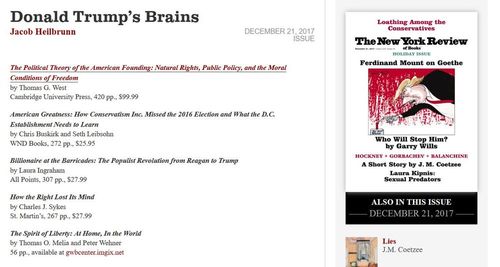From the New York Review of Books:
Donald Trump’s BrainsI’m more than a little vague on how the different flavors of Straussianism tie into Trump vs. NeverTrump.Jacob Heilbrunn DECEMBER 21, 2017 ISSUE
,,, A battle for the future of conservatism is in effect being fought between these anti-Trump conservatives and pro-Trump conservatives associated with the Claremont Institute, a right-wing think tank based in California, which for years has been discussing the Federalist Papers, the dangers of progressivism, and, above all, the wisdom of the German exile and political philosopher Leo Strauss, who taught for several decades at the University of Chicago. …
Until recently, the Claremont Institute had been seen as an outlier in the conservative firmament. For decades, the guiding spirit of Claremont was a brilliant and querulous scholar named Harry Jaffa. In 1964, Jaffa, who had been Strauss’s first disciple at the New School for Social Research and had followed him to Chicago as a student, worked on Barry Goldwater’s presidential campaign as a speechwriter, and soon after joined Claremont McKenna College in California. There he cultivated what became known as “West Coast Straussians,” in opposition to “East Coast Straussians.”
His main antagonist was Allan Bloom at the University of Chicago, author of the 1987 best seller The Closing of the American Mind. A number of Bloom’s students went on to become prominent academics or government officials, including Paul Wolfowitz and Francis Fukuyama. Other East Coast Straussians include William Kristol, who studied with the conservative political philosopher Harvey C. Mansfield at Harvard, and Yuval Levin, the editor of National Affairs and the champion of the “reformicon” movement, which attempts to appeal to the middle class rather than focusing on tax cuts for the wealthy.
After Strauss’s death in 1973, the battle among his disciples over his true legacy erupted. The main subject of disagreement was the nature of the American founding. The West Coasters maintained that the Founding Fathers had created a uniquely virtuous republic marked for greatness by drawing on biblical and Aristotelian principles.2 The result was an Athens on the Potomac with Abraham Lincoln as its philosophical statesman.3 The East Coasters suggested a different and more equivocal verdict: the founding, based on liberal Lockean precepts, fostered the rise of a bustling commercial society but did no more than that. The effort was worthy but merited only a passing mark—“low but solid,” as the Straussian phrase had it. The East Coasters, who formed much of the backbone of the neocon movement, were former liberal Democrats who looked askance at Barry Goldwater and aspired to curb, not eliminate, the welfare state. They saw, and continue to see, immigration as a national blessing and ended up embracing a missionary view of American foreign policy.
Over the past few decades, the East Coast Straussians have enjoyed an easy dominance over their West Coast brethren. In the Trump era, however, Claremont’s reputation has been growing, as has its influence.
Bloom’s Straussianism is sort of an updating of Plato’s call for philosopher-kings in The Republic, which Bloom translated. In Bloom’s view, the philosophers deserve to rule but need a facade, so they will rule through “the gentlemen” (e.g., George W. Bush). Not surprisingly, this makes for a pretty good cult with the old sage telling his young favorites that they deserve great power, although they have to be sneaky about how they exercise it.
I’m not really up to speed on Jaffa’s Straussianism.
But … my guess would be instead that the long series of bizarre Current Year incidents at Claremont Colleges contributed to the Claremont Institute crowd developing a more sophisticated awareness than the mainstream boys.
Just as the 2006 Duke Lacrosse Hoax was central to the new awareness of Trump speechwriter Stephen Miller, the 2004 hate hoax in which a Claremont McKenna professor named Kerri F. Dunn tried to frame her Straussian male students in a hate crime probably opened a lot of eyes among Claremont conservatives. My 2004 article in The American Conservative, “Claremont Hate Hoax” was one of the earlier uses of that alliterative term.
Since then I’ve tracked a long series of crazy things happening at the Claremont Colleges. For example, there was the Harvey Mudd STEM college’s decision to walk the walk when it comes to diversity and inclusion by letting in a whole bunch of unqualified minority coeds, who promptly melted down emotionally. Or there was the time recently when whites were banned from a geology class at Pomona (Claremont’s flagship).













